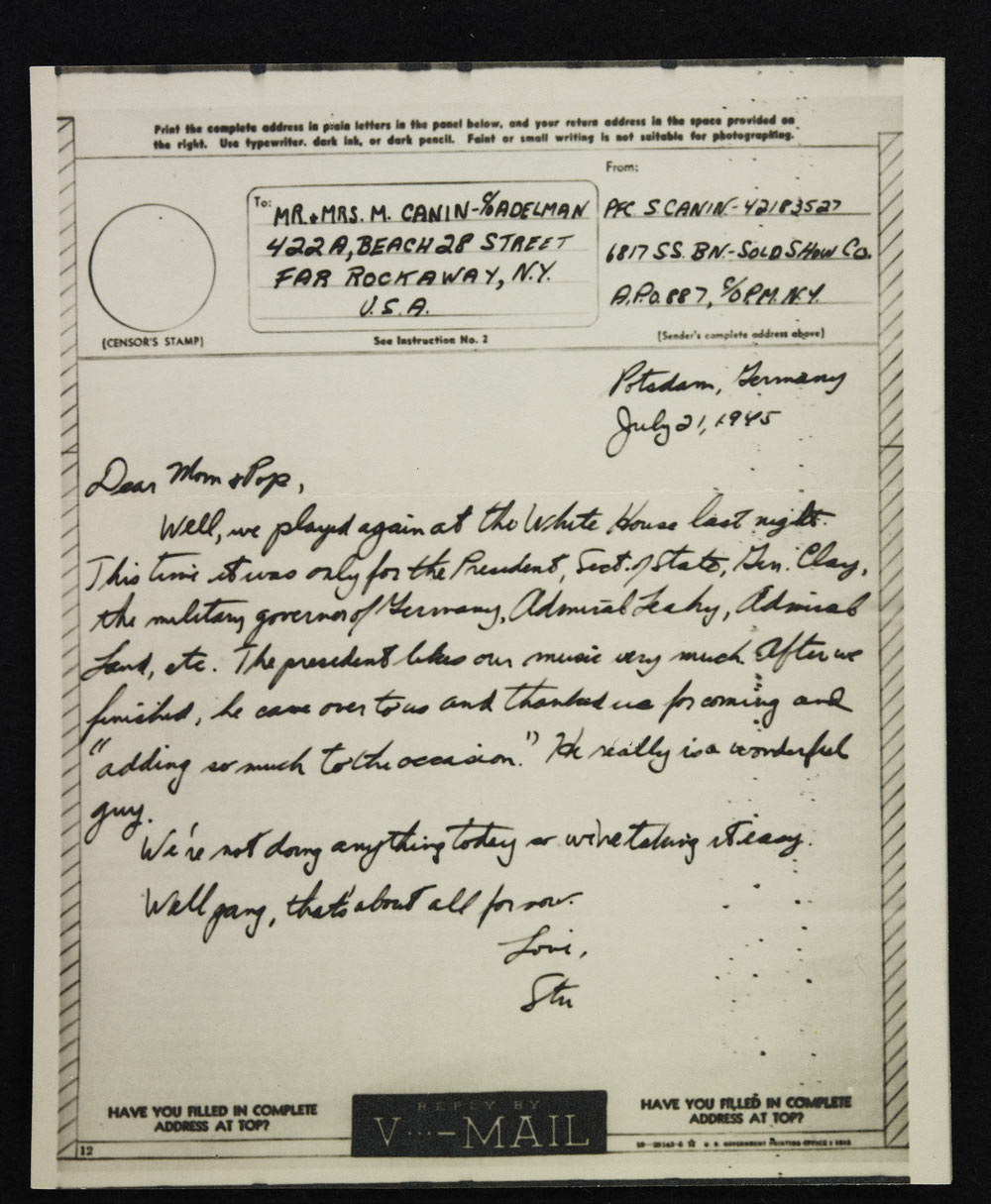As an eighteen-year-old GI, Stuart Canin set out to fight the Germans with a rifle on his back and his violin “because you never know.” He wound up playing a private concert for the Big Three at Potsdam on July 19, 1945, to “break the ice” of negotiations Truman was about to undertake with Joseph Stalin.
This page–designed to complement an archive at the Hoover Institution–documents the end of World War II and the beginning of the Cold War through the experience of renowned violinist Stuart Canin, who performed private concerts three times at President Truman’s request “to lighten the mood” of the Potsdam Conference between July 19 and July 27.
Experience Canin’s story illustrated by primary materials, including letters he wrote to his parents in July 1945 and photographs he took while stationed in Europe. Scholars may also wish to peruse oral history interviews recorded at Canin’s home in Berkeley, California in October 2014.
Trailer for The Rifleman’s Violin, a documentary directed by Sam Ball and produced by Abraham D. Sofaer. This film recounts the remarkable story of Stuart Canin, who set out to fight the Nazis and wound up giving the Big Three a private concert at President Truman’s request.
The Story
In February 1945, an eighteen-year-old American named Stuart Canin, already an accomplished violinist, shipped off to Europe with his rifle on his shoulder and his violin on his back. When the officer at the top of the ship’s gangplank asked why he was bringing a violin to war, the young rifleman replied, “Because you never know.”
Stuart Canin 1945, Stuart Canin Papers, Hoover Institution Archives, Stanford University
When Stuart disembarked, he learned that the fighting in France was drawing to a close.
He joined trains full of soldiers moving closer and closer to the German front, eventually arriving in Kassel, Germany. When the war in Europe ended on May 8, 1945, Stuart received orders to join the 6817th Soldiers’ Show Company. After a few weeks entertaining wounded troops, Stuart was dispatched to Potsdam.
GIs aboard a “forty-and-eight” boxcar in Germany, 1946, Stuart Canin Papers, Hoover Institution Archives, Stanford University
The ruins of Hitler’s chancellery, 1945, Stuart Canin Papers, Hoover Institution Archives, Stanford University
The Big Three at Potsdam Conference, July 25, 1945, Charles Hodges Photographs, Envelope K, Hoover Institution Library & Archives, Stanford University
Canin wrote daily letters home to his parents, detailing his impressions of the history he was witnessing, including President Truman’s confident mood.
He later surmised this change in mood may have been due to Truman’s receipt of a secret memo describing the success of the Trinity nuclear tests. At Potsdam, Truman decided to destroy Hiroshima and Nagasaki, bringing the horrific power of the atomic bomb to modern warfare.
Excerpt of strike order of Hiroshima mission, Strike Order #35, United States, Army Air Forces, 509th Composite Group operations orders, Hoover Institution Library & Archives, Stanford University
To view the original strike order in full, visit the Analysis page.
Letter from Potsdam, July 20, 1945, Stuart Canin Papers, Hoover Institution Archives, Stanford University
To read more of Stuart’s letters, visit the Letter Gallery.
Photo by Craig Lee / SF Chronicle
Stuart Canin went on to become one of the premiere American violinists of his generation. After completing his tour of duty with the army’s 6817th Soldiers’ Show Company in Europe, he attended Juilliard and became the first American to win the Paganini International Violin Competition in 1959.
Read Mr. Canin’s bio to learn more about his accomplishments.
Portraits of Stuart Canin, 1933–2014, Stuart Canin Papers, Hoover Institution Archives, Stanford University
Oral History
Stuart Canin served as a rifleman in World War II until Germany’s capitulation, when he was conscripted into the army’s 6817th Soldiers’ Show Company.
This page features video and audio oral history interviews, as well as a collection of personal photographs that bring to life the war through Canin’s eyes.
Click to download oral history transcripts. All interviews conducted in October 2014 in Berkeley, California.
Photos from World War II
April 1942–July 1945
GI Symphony Tour
August 1945–August 1946
Letters from Germany
July 1945

























